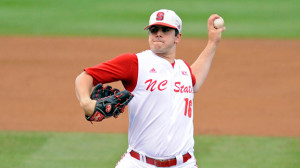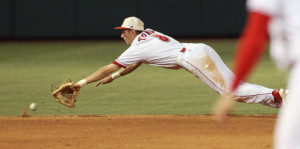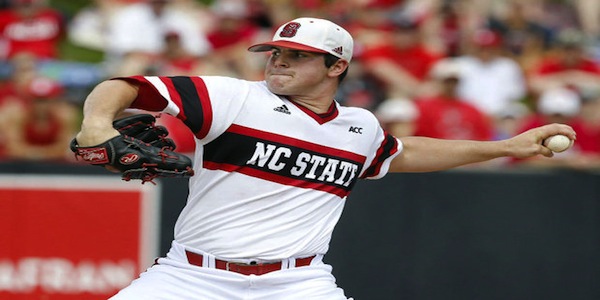2014 MLB Draft Board
Unlike every other draft in the known universe the MLB draft does not have a set number of picks in the first round. Compensatory picks change the total number of first rounders from year to year. This year 34 players will get to say they were “first round picks”, ignoring the sandwich round because if those guys say it, they’re filthy liars. Below are the top 34 players available in the 2014 MLB Draft.
1) Carlos Rodon – LHP – North Carolina State
Rodon has put together as good an entire body of work as any college pitching prospect in history. He’s a big, strong kid with sound mechanics and top-of-the-rotation stuff. After a record setting sophomore season some may have set expectations too high, but to qualify Rodon’s junior year as anything other than a success is flat out wrong. He has huge upside and is likely to get there, Rodon shouldn’t go any lower than second overall.
2) Brady Aiken – LHP – Cathedral Catholic HS (CA)
As good a high school lefty as has come out in recent years, Aiken has polish and poise that usually doesn’t accompany the kind of great raw stuff he also boasts. A terrific athlete, Aiken has a chance to develop elite command of plus, or better, stuff across the board. His fastball movement alone will keep bat makers in business for years. A potential number one starter and possible franchise guy.
3) Tyler Kolek – RHP – Shepard HS (TX)
So big and physically imposing that Prince Oberyn Martell might think twice about tangling with him. Kolek throws as hard as consistently as any high school pitcher in memory. While the 100+ MPH velocity generates headlines Kolek has shown quality breaking stuff; both his slider and curve-ball could be real weapons for him. A better feel for pitching than he’s given credit for gives hope that he may tap into his upside. Risky, needs to repeat his mechanics better but I don’t know how you put a ceiling on him. Virtually unlimited upside.
4) Kyle Schwarber – OF – University of Indiana
Criminally underrated by most, Schwarber has the best chance of developing into an above-average offensive player of anyone in the draft. His elite level production, beautiful swing mechanics and surprising athleticism make Schwarber one of the safer players in a draft very thin on position talent. A college catcher, Schwarber’s below-average arm will likely force a move to a corner outfield spot but a potential 900 OPS should alleviate any defensive or positional concerns.
5) Alex Jackson – C/OF – Rancho Bernardo HS (CA)
Most likely the first position player selected, Jackson shows good power potential and solid athletic tools across the board. Others are more bullish on Jackson’s future hit tool than I am, but I still see him settling in at at least average in that regard. Similar to Schwarber, Jackson has caught a lot as an amateur but may move to a corner outfield spot permanently in the pros, even though he has plenty of arm strength, in order to stay healthy and speed his development. He may not be quite as a safe a pick as Schwarber but Jackson probably has the highest offensive upside of anyone in the draft with a realistic chance of developing into a middle-of-the-order bat.
6) Grant Holmes – RHP – Conway HS (SC)
Small stature may force Holmes down some draft boards but a big arm has him high on mine. Owner of maybe the third best velocity in the draft class (outside of #2 Kolek and #30 JB Bukauskas) Holmes also has a terrific breaking ball. Holmes’ arm works well; he is the picture of easy velocity. If his change-up comes along he’s a potential front-line starter with enough present stuff to make a big league career pretty likely for a high school right-hander.
7) Touki Toussaint – RHP – Coral Springs Christian HS (FL)
The battle for third best high school pitching prospect is a close one between Holmes and Toussaint. While Holmes has slightly better stuff right now, few pitchers have flashed more upside than Touki Toussaint. A good athlete, owner of a projectable frame with a live, loose arm Touki Toussaint is the kind of prospect a scout can really dream on. He’ll snap off knee-bending curve-balls and run his fastball occasionally into the mid-90s. Though he’s still learning the finer points of pitching and may need a slower development program Touki Toussaint has top-of-the-rotation upside.
8) Nick Gordon – SS – Olympia HS (FL)
If you put any stock in bloodlines Gordon should be the morning line favorite over California Chrome in the Belmont, the brother of LAD infielder Dee and son of former big league pitcher Tom. Nick Gordon should make a name for himself thanks to plus athleticism and soft hands which should allow him not only to stay at shortstop long-term but be an asset there. What kind of career Gordon ends up having will be determined by how much his bat improves, he has a chance to hit for decent average. If he can get on-base enough he’s a prototypical lead-off hitter. If not, he definitely won’t have enough power to hit anywhere other than the bottom of a line-up.
9) Sean Newcomb – LHP – University of Hartford
A small school lefty, Newcomb looks like a potential MLB workhorse. Above-average, potentially plus, velocity combines with an above-average hard slider to give Newcomb two presently solid offerings. He also throws a slow curve-ball and burgeoning change-up, both of which could end up as average big league pitches. He struggles with his command a little more than you’d like to see from a college hurler, but Newcomb’s mechanics are clean and as a cold-weather kid he has fewer innings on his arm than young pitchers in the south who throw year-round. A quality four-pitch mix, smooth mechanics and a 6-foot-5, 240 pound frame could lead to a long, productive MLB career as a No. 3 starter.
10) Trea Turner – SS – North Carolina State
The fastest player in the draft, Turner should get to the big leagues on the strength of his defensive range and base-running alone. His physical gifts and a big freshman year once had Turner on the short list of potential number one overall picks but a high ankle sprain his sophomore season robbed him of his top-of-the-scale speed as he limped to a mediocre season amid high expectations. While Turner didn’t rewrite the record books as a junior he did show the kind of plate discipline you want from a potential lead-off hitter (37 BB and just 25 K in 256 plate appearances). Power won’t be much a part of his game at the big league level but if Turner can punch line-drives and take his walks he’ll develop into a quality all-around player and one who could lead the league in steals.
11) Brandon Finnegan – LHP – Texas Christian University
An undersized but effective college lefty who dominated opponents with a fastball he can run into the mid-90’s, a well-above-average breaking ball and solid change-up. Worse case scenario he’s a high-leverage reliever, best case a borderline No. 2 starter.
12) Aaron Nola – RHP – Louisiana State University
Elite performer with advanced command of above-average stuff, Nola is a likely top 10 pick for a team who values present ability over upside. A funky delivery and possible injury concerns lower him on my board but he’s both healthy and good enough to get MLB hitters out right now.
13) Michael Conforto – OF – Oregon State University
A mediocre athlete who’s no guarantee to stay or have much value in left field, Conforto will make his money as a patient, power bat. Above-average bat speed, natural loft in his swing and raw strength give Conforto plus pull-power. If his colliegate walk rates are truly indicative of a keen eye at the plate, he’ll get on-base enough to be an average offensive threat with some upside given his power.
14) Michael Chavis – 3B – Sprayberry HS (GA)
A smaller, but stout right-handed high school infielder Chavis could figure at either third or second base down the line. Where ever he plays the bat will carry him as he’s one of the more polished high school hitters in the draft. Chavis is an intriguing pure hitter with a chance to hit for above-average power.
15) Monte Harrison – OF – Lee’s Summit West HS (MO)
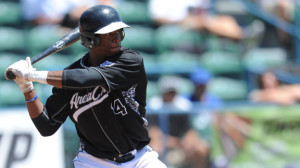 The best all-around athlete in the draft, Harrison has shown plus speed and 70-grade arm strength as well as impressive physical strength that should lead to at least above-average power down the line. A multi-sport athlete Harrison is a little raw at the plate, but has shown enough talent to make me think he’s capable of tapping into his outstanding natural talent.
The best all-around athlete in the draft, Harrison has shown plus speed and 70-grade arm strength as well as impressive physical strength that should lead to at least above-average power down the line. A multi-sport athlete Harrison is a little raw at the plate, but has shown enough talent to make me think he’s capable of tapping into his outstanding natural talent.
16) Derek Hill – OF – Elk Grove HS (CA)
One of the draft’s fastest rising players over the past month or so, Hill has shown elite speed, at least a 70-grade and bordering on 75, to go along with improving offensive skill. Hill projects as an outstanding defensive center-fielder and there’s now optimism he could be a league-average offensive player to boot.
17) Kyle Freeland – LHP – University of Evansville
Freeland has put up video game numbers against low-level competition including a strikeout to walk ratio of over 10-to-one. Above-average fastball velocity and a potentially plus slider moved Freeland way up draft boards this spring but late rumors of worrisome medical reports have pushed him back down.
18) Casey Gillaspie – 1B – Wichita State University
An prodigious college performer, Gillaspie put up a .389/.520/.682 slash line for the Shockers this spring showcasing pure hitting ability, power and patience (walking in 21.4% of his plate appearances this spring). The switch-hitting Gillaspie is limited to first base defensively but for a team willing to live with a lack of defensive value Gillaspie is one of the few guys in this draft who can really hit.
19) Forrest Wall – 2B/CF – Orangewood Christian HS (FL)
Another guy with medical concerns, Wall has had two separate shoulder injuries including a torn labrum which robbed him of most of his arm strength and forced a move off of shortstop. In recent weeks Wall has shown himself healthy and combines one of the better swings in the high school class with terrific speed. If a team’s medical staff clears him, Wall has as much talent as anyone who’s likely to be available in the back-half of the first round.
20) Justus Sheffield – LHP – Tullahoma HS (TN)
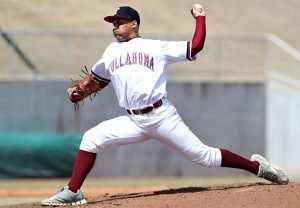 A strong commitment to Vanderbilt, where his brother Jordan is on the team, may keep teams from drafting Sheffield in the first round, not his talent. A strong, compact lefty, Sheffield has flashed plus velocity and has good feel for both a change-up and a curve-ball. Sheffield’s motion is smooth, his arm action short and he figures to have good command as he matures. Command of a quality three-pitch mix and clean mechanics could make Sheffield a steal if a team can talk him out of attending college.
A strong commitment to Vanderbilt, where his brother Jordan is on the team, may keep teams from drafting Sheffield in the first round, not his talent. A strong, compact lefty, Sheffield has flashed plus velocity and has good feel for both a change-up and a curve-ball. Sheffield’s motion is smooth, his arm action short and he figures to have good command as he matures. Command of a quality three-pitch mix and clean mechanics could make Sheffield a steal if a team can talk him out of attending college.
21) Sean Reid-Foley – RHP – Sandalwood HS (FL)
A well-built, athletic righty, Reid-Foley has shown above-average velocity and solid feel for off-speed stuff including a slider that has swing-and-miss potential. If a team believes in his change-up and curve-ball they could see Reid-Foley as a potential No. 3 starter with some upside.
22) Ti’quan Forbes – SS – Columbia HS (MS)
In recent years there always seems to be a prospect from Mississippi who shows athleticism but is doomed by a lack of feel for the game. Forbes might be the next in that group but he does have a few things going for him, he should stay up-the-middle defensively and as a 17-year-old he’s one of the younger prospects in this draft. Forbes has shown some baseball skills so he’s not starting from scratch but he remains a risky, boom or bust type prospect.
23) Tyler Beede – RHP – Vanderbilt University
Likely to be the 18th person in history drafted in the first round twice, Tyler Beede has been up-and-down in his high-profile college career. At his best, Beede shows well above-average stuff across the board, running his fastball into the mid-90s with feel for a couple of secondary offerings. Command is a huge struggle for Beede, but there’s a chance the right pitching coach unlocks his potential.
24) Nick Burdi – RHP – University of Louisville
A flame-throwing college reliever, Burdi backs up a high-90’s fastball with a terrific slider. Burdi dominated college hitters this spring only allowing one (1) extra base hit all year. Being a pure reliever limits Burdi’s ultimate upside but he could be in a big league bullpen tomorrow and you could see him closing big league games in short order.
25) Foster Griffin – LHP – First Academy HS (FL)
A tall, long and lean lefty, Griffin has shown both solid velocity and excellent feel for a change-up. His pitching mechanics are very smooth and there’s reason to think he might add a little velocity as he matures. Even if his stuff doesn’t improve, Griffin might have enough to make the big leagues as a relatively safe high school pitcher.
26) Kodi Mederios – LHP – Waiakea HS (HI)
Similar to Griffin, Mederios is a smooth high school left-hander with decent arm strength and an above-average feel some secondary stuff. Mederios’ slider is ahead of his change-up but he could easily end up with three above-average pitches. About half a foot shorter than Griffin, Mederios doesn’t offer as much physical projection but present package is pretty good.
27) Matt Imhof – LHP – Cal Poly
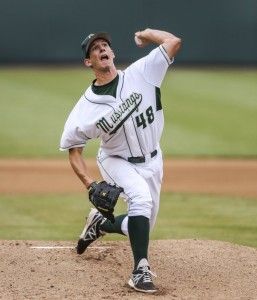
Tall and thin Imhof still offers some physical projection that you usually don’t find in the college ranks. He has above-average velocity, occasionally touching 94-95 MPH, and a quality stable of off-speed stuff helped Imhof be among the nation’s leaders in strikeouts. He gets excellent downhill plane on his fastball, coming from an over-the-top throwing motion. His command is currently below-average but that seems to largely be the function of an unconventional, and somewhat wild, weight shift in his delivery and could be easily cleaned up.
28) Max Pentecost – C – Kennesaw State University
A solid athlete who should be a fine defensive catcher, even without super-elite arm strength, Pentecost leap onto the prospect scene after winning the Cape Cod League MVP the summer before his junior year. Pentecost had a tremendous junior year after not putting up great numbers as an underclassman. There’s buzz that Pentecost could go in the top 10 overall as teams have a history of reaching for catchers. Sadly that history isn’t pretty and while Pentecost could turn into a league-average starter, his mediocre plate discipline and short track record of success also mean he has a significant downside.
29) Braxton Davidson – 1B – TC Robertson HS (NC)
A limited athlete who won’t offer much in the way of positional or defensive value, despite a strong arm, Davidson has some of the better power available in the high school ranks. He’s blasted balls near 500-feet in showcase events but Davidson doesn’t completely sell out power for hitting ability. As a pure first-baseman Davidson will have to hit his way to the big leagues, fortunately that’s something he has a chance to do.
30) J.B. Bukauskas – RHP – Stone Bridge HS (VA)
Despite standing less than the magical six-feet tall, Bukauskas probably has the second strongest arm in the high school class, behind only Tyler Kolek. Bukauskas hits high-90’s relatively often and reportedly touched 100 MPH on one occasion. Rare arm strength would normally have teams lining up to draft him if not for the fact that Bukauskas has a rock solid commitment to UNC and has told teams he’s not interested in pro ball right now. Still, on pure talent he deserves to be in the first-round discussion.
31) Spencer Adams – RHP – White County (GA)
A three-sport star with athleticism and a very projectable body Adams has shown above-average velocity as well as feel for both a slider and change-up.
32) Luis Ortiz – RHP – Sanger HS (CA)
His fastball works 92-95 MPH with some movement has he’s flashed a potentially plus slider but a slight forearm injury he experienced early in the spring may make some teams gun-shy of the high-upside NorCal arm.
33) Jeff Hoffman – RHP – East Carolina University
Hoffman’s big-time stuff kind of came out of nowhere. After struggling as an underclassman Hoffman showed huge upside for a few months before needing Tommy John surgery.
34) Michael Kopech – RHP – Mt. Pleasant HS (TX)
A projection, upside play, Kopech has flashed 95-97 MPH velocity as well as the ability to spin a quality curve-ball. The native of a small East Texas town, Kopech has a deceptive delivery and a live, loose arm.


